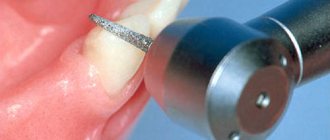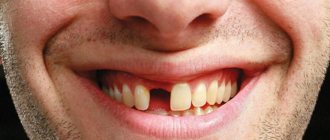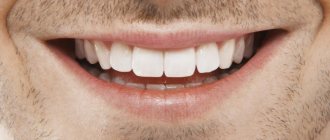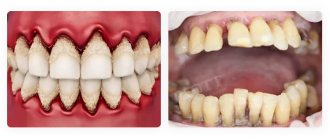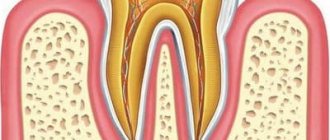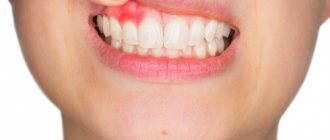A beautiful smile undoubtedly matters to a person. After all, this is what many people fix their attention on when they meet. A smile leaves an unforgettable impression on the interlocutor. It plays an important role in your confidence when communicating. A beautiful smile will improve contact with your interlocutor, improve behavior and leave behind all sorrows and self-doubt, and will also melt the heart of any stranger. But if the smile is not perfect and there is a defect in the front teeth (cracked dental plate, extracted tooth, crooked bite or tooth fragment, caries), how can we talk about self-confidence? Such a person will become isolated from others, become withdrawn, stop smiling, and will feel awkward when communicating. All this can leave a mark on a person’s profession and on his personal life.
No one wants to show problems with their front teeth to others, so dentures are the best solution for such patients.
When performing prosthetics after removal, it is important to restore and preserve the functions of the organ:
- Correct bite;
- Shape;
- Natural color;
- Gum health.
Prosthetics of the front teeth is also an aesthetic issue, therefore, to create a beautiful smile, it is necessary to use high-quality, durable materials that will visually look good. In dentistry, several methods of installing dentures are used and leading materials are used to give each patient a dazzling smile.
The main indications for the use of anterior dental prostheses are:
- Cracks in the dental plate, chips, broken teeth;
- Lost teeth or congenital adentia;
- Carious teeth;
- Crooked bite;
- Yellowing or darkening of the enamel;
- Crooked teeth, irregular shape and uneven “facial” surface of the tooth;
- Early unsuccessful prosthetics.
To solve your problem and select the correct method for installing dentures after removing your front teeth, you can consult the Dr. Levin dental clinic by calling the clinic.
Prosthetic options for anterior teeth
- Temporary and permanent;
- Removable and non-removable.
Temporary prostheses are needed for emergency filling of the defect. This option is performed for a broken tooth, extraction, and when removing or replacing other dentures. To do this, temporary plastic prostheses or removable dentures are used to close the existing defect. The wearing period of such implants is 30-60 days. This time will be enough to make a permanent prosthesis and sanitize the oral cavity.
Permanent prosthetics are performed after the root implant has healed, with healthy neighboring teeth, and in the absence of inflammatory changes in the oral cavity.
Removable prosthetics can be used in people who, due to contraindications, cannot currently perform such a procedure and it is postponed for some time. Or when it is not possible to install a prosthetic bridge due to the lack of more than four teeth in a row or the supporting teeth are damaged. Such patients are recommended to wear removable dentures.
Fixed prosthetics are carried out according to indications and include the following techniques:
- Implantation;
- Bridge prosthetics;
- Installation of crowns;
- Installation of veneers or lumineers.
There are several options for prosthetics of the upper and lower front teeth
Crowns
If the roots of the front tooth are in satisfactory condition, the patient may be offered a crown. This type of prosthesis looks like a cap, which is placed over a previously prepared stump or artificial pin.
Since the front teeth are the decoration of a smile, it is very important that the crown being installed is made of high-quality and highly aesthetic modern materials. The best solution in this situation is zirconium dioxide. It has the same light transmittance as natural enamel, so it does not stand out at all from the background of healthy units.
A cheaper option is metal ceramics. It also looks decent, but due to the metal content in the frame, it provokes darkening of the gums. This can negatively affect the appearance of your smile.
Implantation of artificial teeth
A modern, long-lasting option for the restoration of front teeth is implantation. This operation involves inserting a special pin into the jaw bone, in the place where a tooth is missing, which will act as a tooth root and will counteract atrophic changes in bone tissue. This pin is made of titanium and does not cause any inconvenience or complications in the future. Then a crown made of ceramic is installed on this titanium rod. Implantation makes it possible not to touch the healthy teeth in the neighborhood. For this procedure, high-quality durable implants from the Nobel Biocare brand are used, which are guaranteed for life. The implanted tooth will not differ in any way from the rest, since the crown is made after measurement and exactly matches the shape and natural shade of the teeth. Another technique for using dentures on the front teeth is installing a bridge.
The name “bridge” was borrowed from technicians, since its installation uses the principle of constructing bridges. A bridge is a type of permanent dental prosthesis; they are used to replace defects of several teeth (up to four) in a row. To do this, special crowns are installed on the adjacent good teeth, between which the prosthesis will be placed. The negative quality of this technique is the need to grind down the surface and remove the pulp of healthy teeth on which crowns will be placed. The bridge also needs to be replaced at least once every few years. But with these disadvantages, this method allows you to avoid surgical intervention.
What are Lumineers and when are they used?
Lumineers are another type of orthopedic plates designed primarily to correct the color and shape of the tooth surface. The installation of lumineers, unlike veneers, is carried out in one visit and does not involve grinding of the dentition. That is why there is no need to wear temporary structures before installing them. Lumineers also have an undeniable advantage over composite restorations: thin ceramic plates do not darken over time.
However, there are also disadvantages. Since lumineers are installed on an unground surface, it is sometimes very difficult to achieve a tight fit to the teeth. In addition, the tooth on which the lumineer is attached differs from the natural dentition in size and shape, so it is not recommended to correct local defects with its help.
Prosthetics of anterior teeth using crowns
Sometimes lesions on the front teeth can be more serious. Then prosthetics of the front teeth using crowns is suitable. To make the most natural shape of the tooth being installed and to ensure a tight fit of the crown, it is necessary to grind the affected tooth and, if necessary, remove the pulp and nerve. Then process and seal the canals. After fitting, a ceramic crown is installed on the dental cement mortar. Ceramic or zirconium structures without metal are best suited for dental prosthetics.
The main advantages of such crowns are:
- The base from which the dentures are made must be hypoallergenic. Which is very important. Ceramic crowns do not cause allergic reactions.
- Ceramic crowns look aesthetically pleasing. Based on individual measurements and subsequent fitting, you can ideally select the desired shape and color that will match the natural shade of natural teeth.
- Metal-free crowns do not cause darkening of the gums around the installed tooth and do not leave a metal rim. They also do not lead to alveolitis, gingivitis and periodontitis.
- Ceramic crowns will not cause discomfort when eating food at different temperatures.
- Also, such crowns are lightweight, comfortable and durable.
Prosthetics on implants
When removing front teeth, the most physiological and durable way to restore the dentition is dental implantation followed by prosthetics on implants. Implantation allows you to save healthy teeth from grinding and depulping, preserve the volume of bone tissue and provide the most natural prosthetics. How much does a crown for an implant cost? Front crowns for dental implants are made from different materials.
The best crown for an implant is made of zirconium , but it is also the most expensive. But the cost of a crown for a metal-ceramic implant is almost 2-3 times cheaper, which is explained by the lower aesthetic characteristics of this crown on implants in the frontal area. Quite often, during implantation in the area of the front teeth, the newly installed implant is immediately loaded with temporary plastic abutments and crowns. Temporary crowns on implants are used for 3-6 months. Most often, a temporary crown for an implant is made of acrylic, less often of metal-plastic. Temporary crowns on implants are used for 3-6 months. Most often, a temporary crown for an implant is made of acrylic, less often of metal-plastic.
Just CALL US!
8
We will answer any of your questions and will definitely help you!
What is the price of dentures for front teeth?
The cost of dentures for the front teeth is determined by the following factors:
- type of denture;
- material of manufacture;
- the price segment in which the dental clinic operates;
- qualifications of a dentist and dental technician;
- production time of the prosthesis.
The cheapest prostheses for front teeth are temporary plastic crowns, the price starts from 200 rubles per crown, and the most expensive are zirconium crowns for an implant, the price starts from 25,000 rubles per crown. The price for prosthetics for lower front teeth does not differ from prosthetics for upper front teeth.
Considering the great aesthetic importance of the front teeth, the most reasonable way to restore the beauty and naturalness of a smile is to choose from ceramic crowns or zirconium crowns.
Prosthetic replacement of anterior tooth after extraction
After tooth extraction, it is better to do its prosthetics using the express implantation technique, in the absence of contraindications. To do this, immediately after tooth extraction, an implant and a special abutment are installed in its alveolar socket to form the correct gum shape. A crown is temporarily placed on it. After the implant has healed for approximately several months, a permanent crown is installed.
The advantages of express implantation include:
- This procedure does not require any additional incisions, which is less traumatic to the gums;
- The implant is installed in an open manner, which also does not require additional surgical intervention;
- This method is perfect for patients who do not want to wait until the hole heals and a bridge or crown can be installed.
- Short healing period;
- There are few side complications that are unpleasant for the patient.
Prosthetics to improve appearance. Veneers, Lumineers, Ultraneers
It often happens that the teeth are healthy, but for some reason the owner is not satisfied with their appearance, or there is minor damage to the teeth, for example, small chips, damage to the enamel, severe fluorosis, in this case, onlays may be an option for prosthetics of the front teeth for teeth - veneers, ultraneers or lumineers (in the above series the cost increases).
These are types of cosmetic prosthetics that involve applying thin porcelain plates to the surface of the teeth. Sometimes they are called artificial enamel. Lumineers are thinner than ultraneers or veneers and require less tooth preparation, but veneers are more wear-resistant and allow you to “close” a wider range of dental defects. The thickness of veneers is from 0.7 to 1.3 mm, ultra-veneers - 0.3-0.7 mm, lumineers - 0.3 mm or less. Veneers can hide the following defects: cracks, chips, deviations in tooth shape, defects in the coloring of the tooth surface.
When installing lumineers, there is little or no grinding of teeth; they are manufactured only in a laboratory in the USA. Ultraneers are the Russian analogue of lumineers.
Veneers, lumineers or ultraneers are often installed in pairs or four - on all front teeth, since a tooth with this type of prosthetics can stand out from the rest due to its aesthetics - be overly beautiful).
The choice of the type of onlay is made based on the amount of damage to the tooth tissue and the patient’s requirements.
Installation of dentures for anterior teeth without turning
This is the restoration of damaged teeth, when the neighboring teeth intended for support are not ground down or depulped. In this case, it is worth performing implantation. This is one of the most gentle and atraumatic methods of installing upper and lower teeth. The essence of the method is that in the place of the lost tooth, an implant is installed in the jaw bone tissue, which performs the function of a root. Subsequently, a crown is put on it.
There are also methods that do not require grinding of a layer of healthy teeth, but they are rather temporary.
Implants as a way to restore front teeth
One of the most durable ways to restore front teeth after extraction is to install implants. This method of restoration saves healthy teeth from excessive grinding and also preserves the volume of bone tissue. The price varies depending on the materials used to make the implant crown. The most inexpensive crown for an implant is made of metal ceramics; zirconium crowns are more expensive, but they are considered the best in quality. The high cost of zirconium crowns is explained by the fact that from an aesthetic point of view they perform better over time. The use of zirconium dioxide is one of the most modern methods of dental prosthetics and making crowns. Zirconium dioxide has excellent strength characteristics, the likelihood of chips and cracks is minimized, this material can be used in almost all, even the most complex, cases of prosthetics. The use of ceramic mass in addition to zirconium slightly reduces the cost of such crowns or dentures. Acrylic is also used to make crowns, but only for temporary crowns, as an immediate load; use them for six months.
Veneers and Lumineers
Veneers and lumineers can be used as aesthetic options for dentures on the front teeth. Veneers are very thin shells of porcelain that are given a color similar to the natural color of the patient's teeth. Veneers completely match the shape of a natural tooth. Such plates are attached to the front surface of the tooth.
Lumineers are transparent and very thin plates about 0.15 mm thick. Placed on the front surface of the tooth. This cosmetic procedure is non-invasive, quick, painless and long lasting.
These qualities determine the indications for the installation of veneers or lumineers:
- Crack and small chip of a tooth;
- Yellowing or darkening of tooth enamel;
- Uneven frontal surface;
- Crooked teeth.
Photos before and after
Patient: Nina Sergeevna, 62 years old
Complaints: The patient was not satisfied with the appearance of the old anterior and posterior metal-ceramic crowns and the condition of the gums.
Treatment:
A complete replacement of old crowns on the upper and lower jaws was carried out, new crowns were made from zirconium dioxide with preliminary wax modeling of future crowns. A comprehensive treatment of the gums was carried out to restore the color of the gingival margin.
Number of visits to the clinic: 7
Doctor: Brodsky Sergey Evgenievich
Patient: Lyudmila, 36 years old
Complaints: The patient was not satisfied with the shape and color of her front teeth
Treatment:
10 veneers were made for the upper jaw, and 10 veneers for the lower jaw with preliminary wax modeling of future dentition
Number of visits to the clinic: 6
Doctor: Brodsky Sergey Evgenievich
Patient: Ekaterina, 38 years old
Complaints: Absence of a front tooth in the upper jaw, shape and color of teeth, inflammation of the gums.
Treatment:
An implant was installed in the area of the missing front tooth, zirconium crowns were made on the upper teeth, and 6 ceramic veneers were made on the front teeth of the lower jaw. Comprehensive gum treatment was carried out.
Number of visits to the clinic: 10
Doctor: Brodsky Sergey Evgenievich, Seredin Evgeny Vasilievich
Patient: Victoria, 47 years old
Complaints: The patient was not satisfied with the shape and color of her teeth
Treatment:
Crowns were made from zirconium dioxide for the frontal group of teeth of the lower and upper jaws with preliminary waxing.
Number of visits to the clinic: 10
Doctor: Brodsky Sergey Evgenievich
Patient: Viktor Alekseevich, 63 years old
Complaints: Absence of front teeth in the upper jaw, decayed and partial absence of teeth in the lower jaw. The patient was completely dissatisfied with the appearance of the anterior dentition when smiling
Treatment:
In the upper jaw, in the area of missing front teeth, implants are installed with a metal-ceramic bridge on them. An implant was installed on the lower jaw, and single metal-ceramic crowns were prepared and installed on the damaged teeth.
Number of visits to the clinic: 12
Doctor: Brodsky Sergey Evgenievich, Seredin Evgeny Vasilievich
Patient: Ekaterina, 52 years old
Complaints: The patient was not satisfied with the aesthetics of the front teeth when smiling, the shape and color of the dentition
Treatment:
At the beginning of the treatment, a wax modeling of the future dentition was made. Then ceramic veneers were made for 6 front teeth, and zirconium dioxide crowns for chewing teeth
Number of visits to the clinic: 8
Doctor: Kurakulov Evgeniy Vasilievich
Installation of prosthetic anterior teeth on the upper and lower jaws
The use of dentures for the lower and upper anterior teeth is almost the same from a practical point of view. The difference may lie in the fact that the installation of dentures for the upper teeth requires more attention from the dentist, since the upper jaw is somewhat less well supplied with blood than the lower jaw, hence healing here will take a little longer. And also, when a person smiles, the front teeth are the first to be seen from above, so it is necessary to pay more attention to the aesthetic side of prosthetics.
Features of prosthetics of upper chewing teeth
When prosthetics are applied to the chewing teeth of the upper jaw, the aesthetic requirements are not so serious, however, even in this case there are some peculiarities. If implantation is necessary as a method of treatment, for 60% of patients who have lost teeth more than a year ago, one common problem will need to be solved - atrophy of the bone tissue of the maxillary sinus (the septum between the oral cavity and the maxillary sinus is too thin), this does not allow implantation without prior sinus -lifting (bone grafting). After bone augmentation, installation of an implant for the upper chewing teeth and further prosthetics differs little from the standard procedure.
Note that modern methods of bone grafting make it possible in most cases to install an implant simultaneously with a sinus lift.
Preparing for dental prosthetics
Many people do not like any dental procedures, and this is due to the fear of unbearable pain. You should not be afraid of dental prosthetics, since the most unpleasant thing you will encounter is tooth grinding and depulpation. And all procedures are carried out using local, good, strong anesthetics.
An important diagnostic point is x-ray examination to determine the number and size of roots.
Other stages of preparation include the improvement of neighboring teeth (removal of plaque, treatment of carious damage), which will serve as a support for the prosthesis. If the tooth is significantly damaged, they resort to extraction, treatment of the canals and their subsequent filling.
For prosthetic treatment of anterior teeth, as for any other manipulation, there are contraindications. They are divided into absolute and relative.
Absolute contraindications include:
- 3-4 stages of cancer;
- Conditions after chemotherapy;
- Immunodeficiency conditions;
- Severe somatic diseases in the stage of decompensated state;
Relative:
- Diabetes mellitus (especially type 1);
- Diseases of the heart and blood vessels, such as hypertension with crisis and angina pectoris;
- Smoking, alcoholism;
- Mental disorders;
- Pregnancy;
- Allergic reactions to dental medications and materials.
Prosthetics for periodontal disease or periodontitis
Periodontal disease or periodontitis are gum diseases, which in the acute stage are a categorical contraindication to prosthetics. But you shouldn’t be upset - modern dentistry has methods for introducing the disease into a stage of stable remission, at which restoration of the dentition becomes more than possible.
During the treatment of periodontal diseases, the gap in the dentition can be replaced with a removable denture that does not require grinding. To strengthen the dentition, the following types of removable structures are used:
- Clasp prosthesis, which effectively strengthens loose teeth, evenly distributes the chewing load;
- A nylon prosthesis is also capable of fixing teeth, but only in the early stages of periodontitis (stages 1 and 2).
When the coronal part is destroyed, but the roots are intact. Crowns
If the root of the tooth can be saved, but the crown of the tooth is completely or almost completely destroyed, then a good option for prosthetics is using crowns. This is a prosthesis in the form of a cap in the shape of a tooth, which is placed either on pre-ground teeth or on a stump insert installed in the root canals.
When it comes to front teeth, there are special requirements for materials from an aesthetic point of view. They should look as aesthetically pleasing as possible, while the requirements for the strength of the frame for them are not as high as for the crowns of chewing teeth, since they are significantly less subject to chewing load.
Typically, dentures for the anterior teeth are made from E-max ceramic or feldspathic ceramic. If it is necessary to install a bridge structure, then zirconium dioxide is used as a frame. At the same time, completely metal-free structures have a more natural appearance under certain types of lighting.
BY THE WAY: CEREC technology allows you to make a permanent crown or veneer and install it within 1-2 hours. That. you can immediately close the aesthetic defect and at the same time save money, because no need for a temporary crown.

